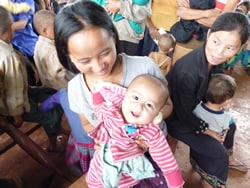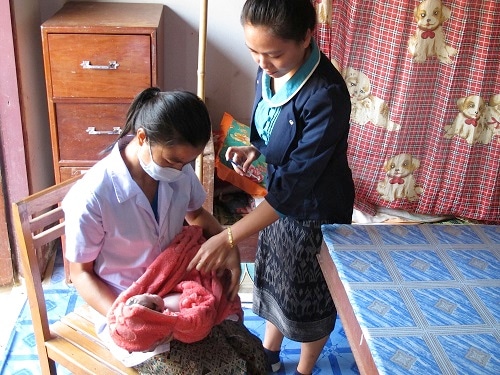Thinking Outside the Box: Innovations in Preventing Hepatitis B at Birth
July 28, 2017
Updated February 24, 2022
This web page is archived for historical purposes and is no longer being updated.

Moms and their kids at an immunization session in Lao-PDR. Photo courtesy of Karen Hennessey, CDC.
Striving for Healthy Babies
Babies born into this world deserve a shot at being healthy. One of the best ways to give babies a good, healthy start is to get them the vaccines they need, when they need them.
Although this may seem straightforward, in some parts of the world it can be a real challenge. But challenges are meant to be overcome and this is why CDC and partners are working with the Lao People’s Democratic Republic (Lao-PDR) to get more newborn babies vaccinated against hepatitis B.
Hepatitis B is known as the “silent epidemic” because infected individuals do not show symptoms for many years, or in some cases even decades. When symptoms do emerge, they do so in the form of liver disease or cancer. The World Health Organization (WHO) estimates that 2 billion people have been infected with the hepatitis B virus, resulting in 620,000 deaths per year and approximately 350 million people living with chronic infections.
The WHO Western Pacific Region, which is made up of 37 countries and territories, has the highest rate of chronic hepatitis B in the world, resulting in nearly 900 deaths per day. Additionally, liver cancer in the Western Pacific region is a serious concern: it is the 3rd most common cancer in the region, compared to the 6th most common worldwide. In most Asian countries, 1 in 13 women of childbearing age has chronic hepatitis B. Infected women who get pregnant can unknowingly pass on the virus to their babies during childbirth.
Fortunately, there is a safe and highly effective hepatitis B vaccine. Newborns of chronically infected mothers who get their 1st dose of vaccine within 24 hours of birth will be 3.5 times less likely to become infected. However, most low- and middle-income countries do not screen pregnant women for hepatitis B, making it impossible to distinguish who carries the virus and who doesn’t. This is why the WHO recommends that all infants receive their 1st dose of vaccine immediately after birth, preferably within 24 hours.
Setting Goals
Governments and health workers in the Western Pacific Region have been working diligently to bring down the number of infants and children infected with hepatitis B. As a result of vaccination efforts, between 2005 and 2012 the Western Pacific Region saw childhood infections fall from 8% to less than 2%.
This progress is impressive and the region is determined to build upon it. With help from the WHO, CDC, and other partners, there is a
CDC’s Dr. Minal Patel works on hepatitis B reduction in the Western Pacific Region and knows first-hand how much progress has been made there. She says, “1 in 8 children born in 1990 was expected to develop chronic hepatitis B infection, compared with 1 in 50 children by 2012. That’s a very rapid improvement over the past 2 decades. If we reach our 1% goal, only 1 in 100 or fewer children will become infected in the future.”
Getting to the final goal of less than 1% is possible, but it will require delivering vaccine to the hardest-to-reach children, including those who live in remote areas, have minimal access to healthcare services, and are the most impoverished.
Accepting the Challenge
Currently, the Laotian health system is set up to deliver vaccines to newborns at health facilities. However, in Lao-PDR, the majority of babies are born at home. Though efforts are being made to encourage more mothers to give birth in health facilities, many women deliver at home because they just live too far away from a health facility. Of the babies who are born at home, it is estimated that less than 5% receive the hepatitis B vaccine within 24 hours. This is a grave problem — if unvaccinated, 90% of newborns exposed to the virus during birth will develop chronic hepatitis B.
Even when babies are born at a health facility, administering the vaccine remains a challenge. Traditionally, the hepatitis B vaccine is kept cold to maintain its potency. But an unreliable supply of electricity and working refrigerators limit the amount of vaccine available in health centers. As a result, less than 20% of newborns in Lao-PDR receive their hepatitis B vaccine within their 1st week of life.
Researchers at CDC recognize these challenges, but also see big opportunities to protect more newborns with the vaccine. Officially, hepatitis B vaccine should be refrigerated, but studies have shown that the vaccine is heat stable and will remain effective for up to 1 month when stored at room temperature. This is referred to as a controlled temperature chain (or CTC) and has been successfully demonstrated with the hepatitis B vaccine, as well as with MenAfriVac™, a vaccine developed specifically for epidemic meningitis in sub-Saharan Africa. Eliminating refrigeration requirements could allow flexibility to clinics that experience interruptions in electricity and could also give community-based health workers the ability to keep hepatitis B vaccines on hand and administer the newborn dose to babies who are born at home.
Creative Problem Solving

A newborn receiving the 1st dose of live-saving hepatitis B vaccine at a health center in rural Lao-PDR. Photo courtesy of Amy Kolwaite, CDC
Based on this information, CDC researchers conducted a 6 month trial. Health facilities were assigned to a study group: 1 group was required to refrigerate their hepatitis B vaccine, and the other group used the controlled temperature chain method. Making this relatively simple change increased childhood hepatitis B vaccination by 28% in the health facilities using the CTC technique and their surrounding villages. Based on this success, discussions are under way about expanding the use of CTC to other areas in Lao-PDR.
Other approaches are also being tried out by CDC researchers, including a focus on skilled birth attendants and mobile phones.
Skilled birth attendants (SBAs) are trained health workers with midwifery skills who provide a variety of services to delivering mothers and their newborns. SBAs are usually the people responsible for administering the birth dose of the hepatitis B vaccine. In reality, there is a communication problem—most SBAs cannot reach the home of a newborn within 24 hours because they do not know that a birth has occurred. In fact, only 37% of women in Lao-PDR have a SBA present during childbirth.
This is where mobile phones come in. Select districts in 2 provinces will participate in a new study. In these districts, health volunteers in a village will receive a mobile phone. When a home birth occurs, the volunteer will use the mobile phone to alert a nearby SBA who can quickly travel to the home and assist with the birth. While there, the SBA can deliver the newborn dose of the hepatitis B vaccine and also provide an integrated package of maternal and newborn care. This includes efforts to prevent common causes of maternal death, neonatal tetanus, and provide education on breastfeeding, clean cord care and the importance of vaccination.
Looking Ahead
Although Patel acknowledges the difficulty ahead, she also expresses optimism for an array of health benefits. “We can use the provision of the birth dose to provide impacts outside of hepatitis B vaccination,” she says. “Services such as encouragement of exclusive breast-feeding, instruction for clean cord care, and making sure that new mothers are not experiencing excessive post-delivery bleeding have been shown to have a huge impact on decreasing maternal and infant mortality and morbidity.”
With creative problem solving such as the programs described above, CDC personnel are confident that the health workers of Lao-PDR can meet their goal of reducing hepatitis B to 1%. Stay tuned for updates on progress made in this endeavor!